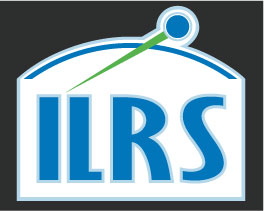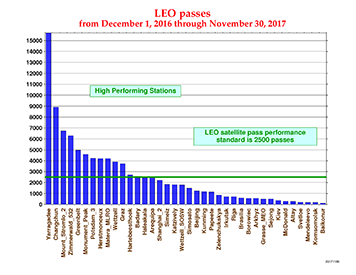Quick Links
- Normal Point Data
- Formats
- Software
- Cite the ILRS
- Revised ILRS station screening process at ILRS Operations Centers (NASA and EDC)
ILRS Data and Products
The ILRS collects, archives, and distributes Satellite Laser Ranging (SLR), Lunar Laser Ranging (LLR), and transponder observation datasets of sufficient accuracy to satisfy the objectives of a wide range of scientific, engineering, and operational applications and experimentation. These data sets are used by the ILRS to generate a number of scientific and operational data products.
ILRS Data: Laser ranging normal points (NPTs) constitute the primary ILRS data product; they are generated following the conclusion of the laser pass and typically transmitted to data centers within hours. Laser ranging normal points are compressed data using all identified signals within a specified time interval. The length of this normal point interval is primarily dependent upon the satellite altitude; lower orbiting satellites have a shorter normal point interval than high-orbit satellites. Full-rate data include all valid satellite returns and are thus larger in volume; these data are routinely provided by most stations in the ILRS network. Full-rate data are useful for both engineering evaluation and scientific applications.
ILRS Products: Products derived from these SLR observations include precise satellite ephemerides, station positions and velocities of sites in the ILRS network, and Earth Orientation Parameters (EOPs, i.e., polar motion and rates, length-of-day).
ILRS Predictions: The laser ranging stations require satellite orbit information in order to point their instrument to the correct location and acquire returns from the retroreflectors. Mission operations centers generate these predicted future orbits from calculated ranging data and radiometric orbits; the files are transmitted to the stations through email or by storing them within data center archives. The Consolidated Prediction Format (CPF) is now used operationally for satellite predictions within the ILRS; CPF provides orbit data that accurately predict positions and ranges for a large variety of targets in tables of X, Y, and Z positions, which can be interpolated for accurate predictions.
ILRS data, products, and predictions are available through two data centers:
- Crustal Dynamics Data Information System (CDDIS) at NASA GSFC, Greenbelt, MD USA
- EUROLAS Data Center (EDC) at DGFI, Munich Germany
Recent News
(1) Data Handling File
(2) Eccentricity Files
(3) SLRF2020 Positions & Velocities
Read more
The ILRS station tracking priority survey results can be found here.
Read more...





